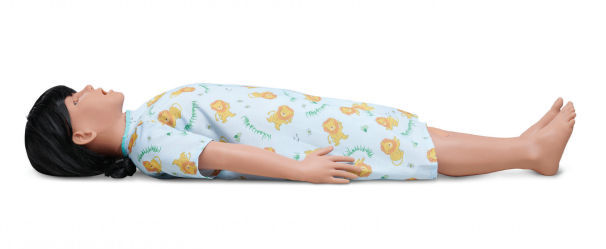Product details
CAE Aria supports the standard healthcare requirements for pediatric patients, from assessment to performing basic clinical skills; and advanced training requirements for PALS, PEARS and APLS.
Features:
Airway
Nasotracheal/orotracheal intubation (ET tube), Retrograde and fiberoptic intubation, Transtracheal jet ventilation, Head tilt, chin lift, jaw thrust, phageal intubatioN, LMA, iGel and King insertion, Oral and nasal pharyngeal airway insertion, Bag-valve-mask ventilation support, Surgical/needle cricothyrotomy.
Tracheostomy, Swollen tongue, pharyngeal swelling and laryngospasms (Advanced model), Intubation depth detection and software event log, Bronchial occlusion, Variable lung compliance and resistance (Advanced model)
Cardiac
Chest compressions compliant with AHA CPR requirements
Effective chest compressions generate palpable femoral pulses and electrocardiogram (ECG) activity
Supports ECG monitoring using real devices
CPR real-time quality feedback and reporting
Chest compression depth sensor
External SimDefib box – Defibrillate, cardiovert and pace using real devices and energy
Library of cardiac rhythms
Software-based 12-lead ECG
Non-invasive blood pressure (BP) with Korotkoff sounds
Circulation
Bilateral palpable pulses with event detection and logging – Carotid, brachial, radial, femoral – Popliteal (Advanced model) – Dorsalis pedis (Advanced model)
Blood pressure dependent pulses
Variable pulse strength
Circumoral cyanosis (Advanced model)
Peripheral capillary refill (Advanced)
Gastric and Urinary
Interchangeable female and male genitalia
Abdominal distention with esophageal intubation
Urinary catheterization with urine output
Orogastric/Nasogastric tube (no fluids)
Gastrostomy tube (with fluids)
Suppository administration
Respiratory
Compliant with 2020 AHA BLS guidelines and 2021 ERC guidelines
Spontaneous breathing
Visible chest rise during bag-valve-mask ventilation
Automatic detection and logging of right main stem
Unilateral chest rise and lung sounds with right main stem
Variable inspiratory/expiratory ratios
Substernal retractions (Advanced model)
Mechanical ventilation support (Advanced model)
Vascular Access
Unilateral anterolateral thigh intramuscular and subcutaneous injection sites
Humeral IO (no fluids) and Tibial IO (with fluids)
Antecubital venipuncture site with flashback
Sounds
Auscultation of normal and abnormal heart, lung and bowel sounds
60+ scripted male/female vocal expressions and sounds
Neurologic
SymEyes
Pain response via sternal rub (Advanced model)
Seizures (Advanced model)”
